Text
Week 9: 11/16/2020

Protesters stand together making a line to block the traffic, Saratoga Springs, November 7th, 2020

Cops in riot gear stand facing protesters (not pictured) despite the protest being peaceful, Saratoga Springs, November 7th, 2020
Personal Experience
X
0 notes
Text
Week 8: 11/02/2020

This is a screenshot of the body paragraph of an email sent to the student body by SGA. In it it covers the issue of cultural appropriation during Halloween.

A photo of costumes that feed into the issue of cultural appropriation during Halloween.
Personal Experience
I
Interview Questions and Answers
1. What was your reaction to COVID when it was first being announced in the media?
2. How do you think being in quarantine affected you? Did you learn anything about yourself during this time?
3. How are you reacting to/dealing with being on campus now and having to transition back into a more public, structured, and social lifestyle while we are still in the middle of a global pandemic?
4. What do you think of Halloween during COVID and the negative outcome it had on the school campus?
5. What is your view on cultural appropriation in Halloween costumes? If you view it as a negative please explain why.
0 notes
Text
Week 7: 10/26/2020

This is an above view of Skidmore Dining hall. The right side of the room is usually called the red side (mostly arts and music kids) while the left side is usually called the blue side (sports students). No matter the believed reason for this group separation it is existent and the people who sit on each side of the dining hall embody their social groups expectations.
Personal Experience
This week the focus was embodiment so I decided to focus on the idea of social chameleons. When I say social chameleons I am referring to the type of person that will change how they act, talk, carry themselves, etc. depending on the situation they find themselves in. While most people will do this to some extent (they will act one way with their friends and another with their parents or professors) there are also people that will do this to fit into different friend groups or as a way to easily assimilate to different cultures. These people are able to blend into different social and cultural groups with little effort because they are able to grasp what is important personality wise in each social group and will model themselves to this mold. Another way this can be done is by copying those around you.
This idea is interesting in the world of COVID because it makes it harder to fully grasp what a person is expecting and therefore makes it harder to correctly embody what is necessary for the given situation. For instance, when going for a job interview you might mimic the movements and positions of the person giving the interview because this will make them subconsciously feel at ease as it shows you are actively listening. However, through a phone call or even through zoom these actions are harder to see and even harder to copy in a noticeable way without seeming strange.
This week I interviewed my friend Emily. Emily and I are both seniors here at Skidmore but did not actually meet each other until we took a semester in London. This is because she is more of a sports oriented student while I am more music and arts focused. We discussed how these differences affected our views and the positive and negative effects of being a social chameleon.
Interview Questions and Answers
1. What was your reaction to COVID when it was first being announced in the media?
Honestly I didn’t believe it was real and I never thought it would reach me. Cases outside of the hot zones were so low it didn’t feel real until I returned home from being abroad. It was so downplayed in the UK it never occurred to me that it would spread the way it did. Also being abroad I didn’t want to believe it. I didn’t want to leave. I didn’t want it to be real.
2. How do you think being in quarantine affected you? Did you learn anything about yourself during this time?
I think being in quarantine really affected me. I spent a lot of time with myself and learning about who I am. Then I opened/created a business selling face masks on Etsy, something I never imagined I would undertake and never mind succeed at. I definitely learned a lot. It wasn't all happy and perfect by any means but I am better for it.
3. How are you reacting to/dealing with being on campus now and having to transition back into a more public, structured, and social lifestyle while we are still in the middle of a global pandemic?
By the time I came back to school a lot of home life had opened up. I was working 40+ hours a week so I did not have a lot of down time or free time. I have a lot of responsibilities on campus so other than the fact that all my classes are online my school life is generally the same. The transition was similar to ones I have experienced in the past.
4. What do you think about the idea of social chameleons (people who change the way they act based on who is around)? How do you think this helps/hinders them?
I understand the purpose of changing how you act based on who is around and I think this is important to a point. It’s important to know how to change behavior based on situations and people (grandparents versus friends, teachers versus parents, etc.) but people who act completely different and maintain no sense of self make a lot of friends but no one truly knows them and maybe they don’t even know themselves.
5. How do you think the social separation of groups on Skidmore campus affects how people act?
I think that the social separation on campus isolates different people from expanding their circle of friends as each group has its own stigma and this stigma often dictates action within these groups. Even the simple red side blue side in the dining hall demonstrates this. Typically athletes sit on the Blue side and artists, actors, and others sit on the red side. I know there is often overlap between the two and it’s not a written rule but it still occurs and the two polar opposites often never interact. I have heard of red side people being afraid of the blue side and blue side people who wouldn’t be caught dead on the red. This simple social grouping completely isolates some from branching out and realizing that no matter what people do or who they are it doesn’t mean they aren’t good people. It causes people to believe the stigma of certain groups and project it on others. If projected enough, or if you’re told enough that you are supposed to act one way it can cause you to act differently. If you go a little deeper you see certain teams that interact with primarily each other and not others or acting groups that don’t socialize with singers. Why? Possibly because of the stigma of these groups the way they typically “act”. I am on a sports team. I live with a singer, an actress, and a musician. I have heard all this said. The singer and actress are friends from a previous school and the actress’s friends at one point rejected the singer from their group. I met the musician abroad but besides that we never crossed paths and she was not friends with the other two either. I became friends with the singer through scoop not through on campus activities. It can be done. The groups can mix. But the social grouping on Skidmore campus does not facilitate this. People are so stuck in their groups it often changes the way they act.
0 notes
Text
Week 6: 10/19/2020
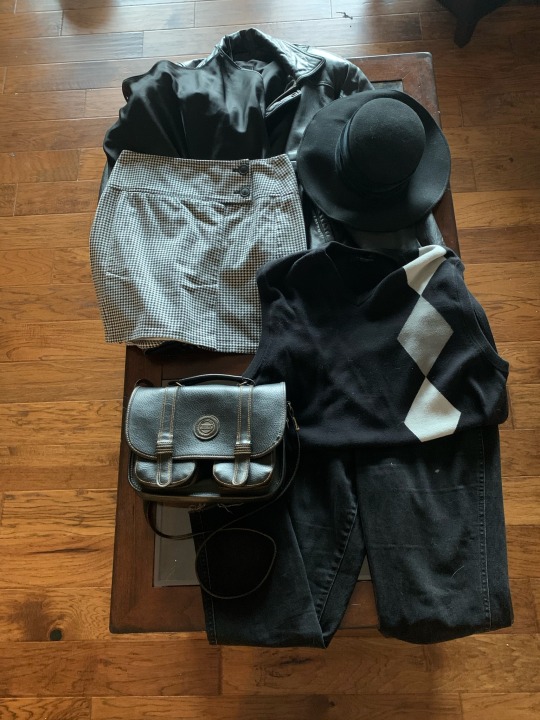
Thrifted clothing bought over the past year (2019-2020) at a collection of different stores.
Personal Experience
Clothing can be very important to how a person identifies themselves. Maybe a person only wears black or only wears bright colors to try and show aspects of their personality. Maybe they wear brand name clothes as a way to show a sense of style and economic status. Or, in the case that I want to focus on here, maybe a person thrifts clothes for in an attempt to show how they identify themselves.
I find the act of thrifting clothes to be particularly interesting because it really lends itself to so many different identities. It can simply be that thrifted clothes are less expensive and thereby better for people of a lower economic class. It could be that someone has a more vintage style and thrifting clothes is an easy and usually cheap way to do this. It could also be that by recycling clothes and not taking part in fast fashion the person is being better for the earth. Whatever the reason, what's clear is that the wide selection of clothes at cheap prices and from a range of periods in time draw a very wide and varied crowd of people.
Another interesting aspect of thrifting is that in recent years it has become culturally popular. People who used to buy a lot of their clothing from name brand stores now find themselves going to thrift shops to see what they can find. People who are particularly good “thrifters” have gained followings through the use of YouTube and social media based on their ability to find good clothes and wear them in a fashionably relevant way. It's interesting that something that, for a period of time, was seen as less desirable then its more expensive name brand counterparts is now very culturally relevant to the extent that new ways to thrift clothes have been invented.
Recently websites/phone apps such as Dpop, Poshmark, and other similar apps have become popular. These websites allow people to post and sell their own clothes rather than bring them to thrift shops. While this isn’t the same as typical thrifting it has been adopted into thrifting culture especially now during COVID when going to shops, particularly shops where the items for sale have been in other peoples homes, isn't necessarily safe.
The person I have interviewed below is with Jacques (21) who is a Senior at Skidmore College. He is from the Boston area and, when the world is not locked down, he goes to thrift stores with friends to buy new sweaters and other clothes that are comfy and cheap. During his interview he talks about his experience with COVID, quarantine, and what he thinks is the impotence of cloths, self defined identity, and the personal and cultural reasoning behind/importance of thrifting clothes.
Interview Questions and Answers
1. What was your reaction to COVID when it was first being announced in the media?
My first reaction to COVID’s mention on the news was concerned but not super scared. I didn’t think it’d become anything at first.
2. How do you think being in quarantine affected you? Did you learn anything about yourself during this time?
Quarantine hasn’t affected me as much as I thought it would. I still feel pretty normal. If anything, it’s taught me that I’m a little more introverted than I thought before. I was fine being at home and found that I could interact with my friends other ways when I felt the need to.
3. How are you reacting to/dealing with being on campus now and having to transition back into a more public, structured, and social lifestyle while we are still in the middle of a global pandemic?
I feel okay about socially interacting now that we’re back here at school. My housemates and I keep our circle pretty tight and Skidmore has been safe. If I was somewhere else where there’s a breakout I'd be more worried.
4. Do you think people define themselves and others by the clothing they wear? Explain.
5. Why do you think people thrift clothes (reasons beyond personal identity)?
People thrift besides personal identity for economic reasons. Lots of people can’t afford new clothes and the second hand clothes that are offered at thrift shops are cheaper but still wearable. Also it let’s people experiment with new or risky styles without having to worry about how much money they are spending on clothes they might not wear that often.
1 note
·
View note
Text
Entry 5: 10/12/2020


Kaylee (top left and person being interviewed), 21, Georgia, Maya (top right), 21, New Jersey, Alex (bottom), 21, Virginia
Personal Experience
There are two categories anthropology can fit into, thin and thick. Thin anthropology, in relation to the images above, would simply state that we were all giving a thumbs up with our palms facing in. Alternatively, thick anthropology would look deeper to say that this could mean we were happy, we were responding to a question, or there could be some other unknown meaning. This is important in day to day life because in different cultures different gestures will have very different meanings and connotations.
Due to the Pandemic wearing face masks has become a norm along with holding classes and other social gatherings over zoom. Due to this some more person directed gestures have become obsolete as they aren’t possible through zoom meeting rooms where you can’t really direct a glance or hand movement at a specific person. Another aspect of gestures that has become problematic during this pandemic is greetings that we do in passing. People who would normally smile or use other facial expressions to greet someone are finding they have to find new ways that use more hand gestures or exaggerated expressions that focus on the eyes.
Kaylee is a Junior at Skidmore College who is living off campus this semester. In the interview she explains her experiences regarding COVID as well as how she thinks gestures have had to evolve to account for our new way of living. One of the main gestures we focused on in our general conversation was the thumbs up that people use during zoom meetings. This thumbs up is used to signify that something is going well (i.e. the sound is working, the person has unfrozen, the video is playing correctly, etc.) and is commonly used instead of unmuting your mic. While a thumbs up is usually used to signify something good, these specific characteristics are more recent developments.
Interview Questions and Answers
1. What was your reaction to COVID when it was first being announced in the media?
When COVID was first announced in the media, I thought of it similarly to how I thought of Ebola. Meaning that I thought it was going to be a problem in some areas, but not everywhere. I did not realize how much COVID would affect all aspects of my life.
2. How do you think being in quarantine affected you? Did you learn anything about yourself during this time?
It made me realize that I am better at reaching out than I thought. It also helped me realize that I can get along better with my parents (living wise) than I thought. I had a lot of difficulty before leaving college, and coming home during the breaks was hard since I do not have any friends in my hometown, but COVID made me realize that I can reach out to people to not feel as alone. I also realized that, because I played a lot of online video games and I met my best friend of eight years virtually, that I can cope better without seeing someone than most people. In this regard I am lucky. I also realized that I do have it off better than most people because I was able to stay in a house and not have money issues, which became a grand problem due to COVID.
3. How are you reacting to/dealing with being on campus now and having to transition back into a more public, structured, and social lifestyle while we are still in the middle of a global pandemic?
I like having life return to a more normal, but I miss life before COVID. I miss being able to hug my friends, see their faces, hang out without worrying about anything. One of my teachers brought up a disheartening point, which is that I do not know what many of my classmates' faces look like. I feel isolated in my French class because not only do I not know anyone that well, but wearing masks makes it harder to interact because of the barrier. That said, I am so happy to be back. I consider Saratoga Springs and Skidmore my home, so even with the stress and strain of everyday life with COVID, I think it's worth it.
4. How do you think having to wear facemasks has affected our use of gestures (i.e. do you think we are using more to make up for the lack of possible facial expressions)?
Facemasks greatly affect our gestures. When I pass by someone normally, I smile and close my eyes. It is how I say hello normally. However, with face masks, when I do that I am just closing my eyes to the other person, which does not really count as a greeting. Some other things I do to make up for this is nod my head, try and smile as big as I can in hopes that the other person can tell I am smiling, and waving at people. From my experience, I know that I am using more of my face and other body to try and convey a greeting, or even just a smile.
5. How do you think gestures have had to evolve in order to accommodate new online learning (i.e. using thumbs up, not being able to make person specific gestures)?
Thumbs up have become a staple of online classes. When a teacher is trying to share screens and asks us if it is working, instead of unmuting our mics, we just do a thumbs up (if the teacher continues after a thumbs down, someone will unmute). I think more genres have come into popularity during the time that indicate yes, no, or so-so because it is simpler to do these gestures than unmuting and speaking - which is more difficult in an online class also.
0 notes
Text
Entry 4: 10/05/2020

Lively Lucy’s Board (Spring 2019), Skidmore College, Pictured (moving clockwise): Zach (upper center), Jacques, Maya, Katie
Personal Experience
It is common knowledge that Skidmore students have a tendency to have core groups. Whether this is through a friend group, sports team, or club Skidmore students will eat, hang out, and participate in extracurricular activities with their chosen group. This being said, the idea of a group and how the groups operate has had to drastically change during COVID due to social distancing and other COVID safety rules.
These rules and necessary change in group dynamics have especially affected the performance clubs on campus as, not only are they no longer able to host their regular meetings, they are no longer able to have their normal performances. Due to this the group dynamic as well as the group activities have had to reinvent themselves. One club is Lively Lucy’s Coffee House. This club is an on campus music, performance, and entertainment club that would usually host weekly meetings as well as weekly events out of Falstaff’s. They have begun to make group themed playlists on Spotify as a way to continue in club activity as well as interact with the clubs audience.
While clubs are finding ways to continue their usual work there is still the question of how these new rules and day to day dealings will affect the on campus group dynamic in the long run. Students who are just coming to campus are having to find friends and friend groups without being able to interact with others in a way that is normally seen on campus.
Interview Questions and Answers
(This interview is with Zach, the current president of Lively Lucy’s, and was done over the phone in order to comply with safety regulations due to COVID)
1. What was your reaction to COVID when it was first being announced in the media?
I was in South Carolina at a frisbee tournament so there was a lot of uncertainty, for various personal reasons though I felt weirdly calm about the whole thing
2. How do you think being in quarantine affected you? Did you learn anything about yourself during this time?
My life changed drastically over the 5 months I was in quarantine so I kind of had to learn a lot about myself
3. How are you reacting to/dealing with being on campus now and having to transition back into a more public, structured, and social lifestyle while we are still in the middle of a global pandemic?
I find myself feeling very lethargic in everything I do because even the high energy moments of this semester are just a chill hang out with like 3 people.
4. Skidmore College is known, at least by the students, for having close group dynamics (friend groups, sports teams, etc.). How do you think this has had to change due to COVID rules?
I think that dynamic in some clubs is just obliterated, while organizations like WSPN [the school radio station] have managed to stay together to expect club leaders to foster close relationships in a time where not even college employees who are explicitly employed for that reason can do that, on top of their upperclassmen responsibilities, is just misguided.
5. As the president of Lively Lucy’s, how have you seen the group dynamic change due to COVID rules not allowing in person meetings or the usual shows? Do you think these changes will have a long standing effect on the club?
Lively’s is frankly nonexistent right now. It’s a club born out of a common interest in planning events in a time where event planning doesn’t exist. The only reason I am at all able to deal with that is I know once events do return the club can bounce back pretty easily, we don’t lose too much from taking a year off.
2 notes
·
View notes
Text
Entry 3: 09/28/2020

Kelvin aka Celcius, 20, from Boston area (photo is from 2019)
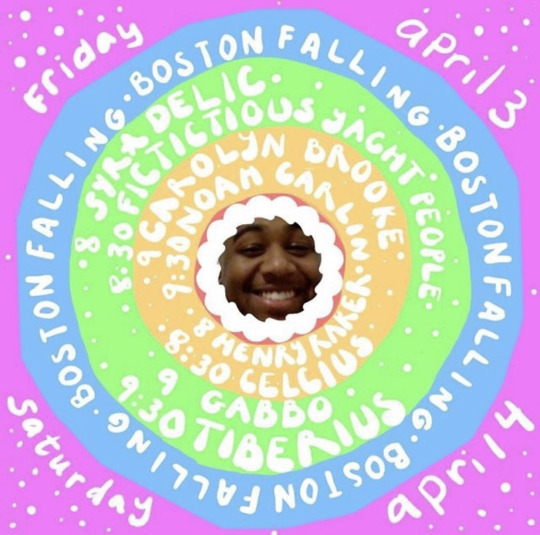
Logo for Boston Falling (designed by Brendan Wright), a virtual concert event that took place April 3+4 2020
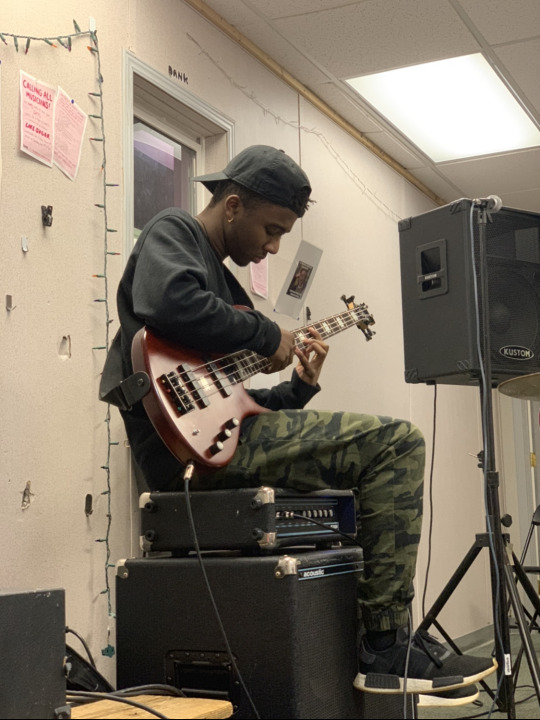
Skidmore band trailer 2019
Personal Experience
Sharing is a universal virtue that strengthens communities through the connections it allows one person to have with another. In the case of bands like the Dobe sharing is integral to their way of life as it ensures everyone will have enough food to eat while also while also causing large scale group cooperation. However, in times like these where the world seems to be on lock down sharing can be seen in a different form.
During this pandemic technology has attempted to make great strides in a very short period of time in order to aid the world population with work and social interaction that allows them to remain socially distant. This time has also seen the rise of events like virtual concerts which allow people to hear bands and experience small aspects of what they feel is normalcy from the safety of their homes.
On April 3+4 a collection of artists, many of whom were Skidmore students or alumni, took part in a virtual show called Boston Falling. This show was self organized and run through Instagram live. This way of sharing is new but shows humans natural want and need to share experiences and creativity even when faced with hardship. Below is a brief interview with Kelvin, aka Celsius, who was one of the shows participants as well as a current Skidmore student.
Interview Questions and Answers
1. What was your reaction to COVID when it was first being announced in the media?
I was actually spending spring break in my Skidmore apartment when I heard the news. Already Being isolated from everyone, I didn’t really care much for it, and it didn’t feel that real. However, I had a rough awakening when Skidmore suddenly decided to kick everyone out. It didn’t really settle in that we were in a global crisis until my mom handed me a face mask and told me that I had to wear this outside if I didn’t want to get sick.
2. How do you think being in quarantine affected you? Did you learn anything about yourself during this time?
I think quarantine made me a much more anxious person. I already used to get super fidgety if I stayed inside the house too long without doing anything substantial. Quarantine made my mental health plummet - I was storing up all these negative emotions inside and I didn’t have any healthy ways of design with it. In a sense, I almost felt dead. I woke up, stared at my phone for hours, played games and snacked, watch a movie, and played more games until I fell asleep. It was the same thing over and over again. I felt like I was wasting away without doing anything meaningful
3. How are you reacting to/dealing with being on campus now and having to transition back into a more public, structured, and social lifestyle while we are still in the middle of a global pandemic?
It’s actually really nice. I almost feel like I’ve regained a sense of normalcy, and it feels like we’ve always had to wear masks. It almost feels strange to not wear one. It’s also really nice to get tested every week, because now I have a definite answer of my health condition as opposed to freaking out and worrying about symptoms I may or may not have and letting my anxiousness consume me. But it’s still important to follow social distance guidelines and to be careful about what you do outside of your house and who you see.
4. How do you think technology has had to evolve during COVID to account for peoples want/need to interact while remaining socially distanced?
There’s a huge pressure for technology to develop even faster than before, because now every single person is relying on doing things remotely. Some people have been able to adapt very quickly and advance their technology, while others have been exposed for their outdated systems. I think it’s both a blessing and a curse. It’s nice to see how far technology has come, but I feel like now people are becoming too dependent on technology and spend too much time glued to the screen. But then again, it’s all they can do nowadays.
5. On April 3-4 you took part in Boston Falling which was a live stream concert event. How do you think Boston Falling and events of the like help people share what they have created during quarantine? Why do you think these events are important?
I think that Boston Falling reminded everyone that music and creativity lives on despite these harrowing times. I think it’s important to have these events because for some people, music and performing are their entire lives, and to have that ripped away so suddenly is tough. Events like these serve to keep the music alive and for non verbal communication to keep going strong. I also think that people have more time and space to focus and really work on the music that they write
0 notes
Text
Entry 2: 09/21/2020
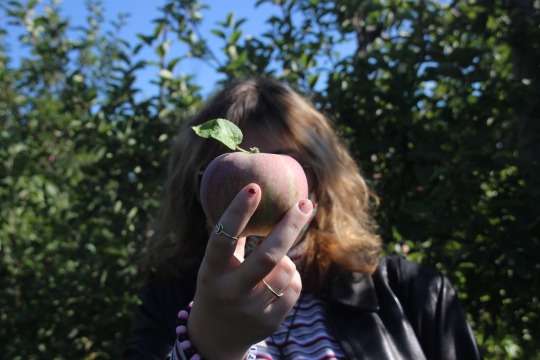
Katie, 21, from New York
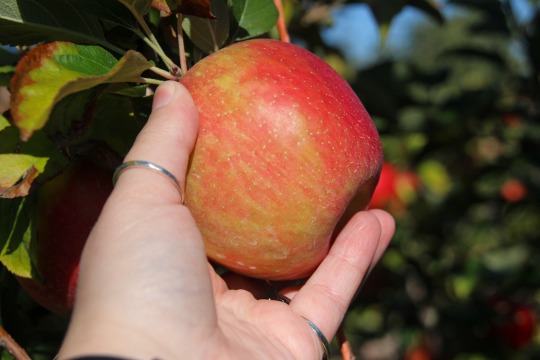

Personal Experience
Oftentimes when you go to the grocery store you are getting food that may have come from other countries and you can never be quite sure how the produce was made, the conditions of the workers, or the mode of transportation. Additionally, because much of the produce has to travel great distances tricks are used to keep it fresh such as using wax to coat root vegetables or using more chemical based preservatives. Because of this some people look to more local means of getting fruit, vegetables, and meat.
My housemates and I have made a bit of a habit going to local farmers markets and such. We like to get the fresh produce and support the local businesses that sell their goods there. This week, in addition to our normal trip to the farmers market, we went apple picking. One thing we were not prepared for was the sheer number of people who decided to pick that day but we soon realized it was also opening day. Despite this the farm workers seemed more than prepared for the crowded and we found ourselves having a good time.
Our enjoyment made me think about how for us, a group of young adults that group up in suburban communities, this was just something we were doing for fun but for others this was the work they did to support their families. When looking at the food we buy at grocery stores something we don't seem to think about is the fact that each item had to be picked, packed, and shipped by a person who does that day in and day out.
Besides wanting to pick our own food and enjoy the early fall weather my housemates and I were also taking part in a Pagan harvest ritual called Mabon. Mabon takes place from the 21st to the 29th of September this year and is a celebration of the Autumn equinox as well as mid-harvest. The idea is that the harvest at this point will be nearing its end and it is a moment to recognize and be thankful for the changing seasons and celebrate the second harvest. Commonly this is celebrated through activities like apple picking, baking, creating an altar and giving offerings of food, and thoughtful meditation.
Interview Questions and Answers
What was your reaction to COVID when it was first being announced in the media?
My reaction to COVID being first announced in the media was definitely a nervous one, but (at least at first) I never imagined it could grow to this scale. I was studying abroad in London, so my main concern was being away from my family in case anyone got sick or I couldn’t come home.
How do you think being in quarantine affected you? Did you learn anything about yourself during this time?
Quarantine definitely gave me a new outlook on life, in a weird way. I was able to spend more time thinking more deeply on what I want from life and how I want to get there. I was able to dedicate much more time to creative endeavors that I hadn’t explored before, and in the process I learned that I really love to paint, and now that’s becoming a go-to relaxing activity for me.
How are you reacting to/dealing with being on campus now and having to transition back into a more public, structured, and social lifestyle while we are still in the middle of a global pandemic?
I’m definitely very stressed about being on campus, honestly. Living off campus was able to relieve some of that stress, as I’m in a much less concentrated area. Due to where I live with my parents being such a hot spot for the virus, I’m not used to being able to have as much freedom as I do on campus, so that was a nice change.
How do you think the general public's relationship with food has changed during the pandemic both in terms of food hoarding, food shortages, and the fact that food pantries are facing an increase in patronage?
I think that the general public’s relationship with food has been greatly damaged by Corona virus- even my mom bulk purchased ramen, referring to it as her “bunker food”, just in case of extreme emergency. Food hoarding and food shortages are definitely very damaging to society as a whole because it heightens the gap between those who can afford to hoard food and continue to purchase abnormal amounts of it and those who cannot, and it leaves those who couldn’t at a severe, even dangerous disadvantage.
What is your view on locally sourced food?
I’m definitely a fan of locally sourced food! I aim to get locally sourced food if I can, given my budget and any availability. I love going to the farmers markets in my town back home and in Saratoga as much as I can, everything is so good there
3 notes
·
View notes
Text
Entry 1: 09/14/2020

Sylas, 21, from Oakland California
Personal Experience:
The assignment this week was to meet someone new but, due to the fact that we are in the middle of a global pandemic and I live off campus, this wasn’t something I was comfortable doing. Instead I met up with my friend Sylas, who I have been friends with since freshmen year, and we decided to hang out how we normally would but try to do it in a way that felt as safe as possible given the new social distancing rules. This saw us having a picnic in the park where we felt safe enough, and could sit far apart enough, to remove our masks.
Once we settled in we decided to catch up about our home lives and found that we had different experiences with the quarantine. Syals is from California which was a pandemic hot spot while I spent part of my summer in New Jersey, which was considerably safer, and part of my summer in a part of Maine that had no reported cases. Due to this Sylas was much more accustomed to the stricter and more vigilante social distancing rules like the ones being followed here in Saratoga and in the Skidmore community.
One thing we did have in common was the fact that we both decided to return to school this year for in person classes, though we both also chose to live off-campus. This came with a social dynamic as well as a living dynamic neither of us had considered. First we found that, because we aren’t living on campus proper we are actually very isolated from the dealings of student life and, while this was expected, we hadn’t considered how this would be magnified by the pandemic and social distancing rules. As for the unexpected social dynamic, we had not considered the tight living quarters with little outside time, the stress and necessary permission asking that came with any and all guests coming over, and the questions that came along with working during a global pandemic.
While the conversation was interesting we were eventually noticed by a swarm of ducks who decided to try and steal our sandwiches so we quickly packed up, put on our masks, and left the park.
Interview Questions and Answers:
1. What was your reaction to COVID when it was first being announced in the media?
I learned about COVID pretty early because my housemate is from Thailand, so she was worried about the safety of her family a while before any cases had hit the US. Hearing the news definitely made me a bit nervous but I assumed that it would be like most other outbreaks and die down quickly.
2. How do you think being in quarantine affected you? Did you learn anything about yourself during this time?
My sense of time was really affected by quarantine. My routine didn’t change day-to-day, so each day blended into each other to the point that whole weeks would go by and I wouldn’t notice. In quarantine I learned that I need more hobbies/interests that don’t revolve around screens. I would spend hours scrolling through the news, social media, and academic articles relating to the capstone I’m writing this semester – and then I would watch a TV show to wind down. To combat this I tried to read books, play guitar, and go outside every day to give myself a screen break.
3. How are you reacting to/dealing with being on campus now and having to transition back into a more public, structured, and social lifestyle while we are still in the middle of a global pandemic?
I’m living off-campus so I feel pretty distant from the typical college experience and environment. If I was living off-campus without the pandemic, I imagine I’d feel a similar sense of distance—something I experienced when I studied abroad and lived 25 mins from my school. The combination of living off-campus and the pandemic make me even more excited when I see friends (from afar), go to in-person classes, and see the hustle and bustle of student life around campus.
4. How do you think new social distancing rules are going to affect how we interact with one another? (Both old friends and new people)
It’s become necessary to have conversations about boundaries and comfort with each person I spend time with, and I think these conversations will continue for the foreseeable future. While the circumstances suck, talking about boundaries is a really important skill to have and can be transferred to many other aspects of life.
1 note
·
View note
Text
Cultural Anthropology
From this point until further notice this account is going to be used to complete an ethnographic project looking at topics common to cultural anthropology as well as how COVID and the quarantine have affected peoples lives. Please feel free to comment, ask questions, or engage in any other way you see fit. Thanks!
0 notes
Text
Week 11: Feedback Reflection
Feedback:
Your solution for reinventing your photo series is very good. The title and captions bring new meaning to all your photos in a way that works very well, although the two on page 6 are very (too) similar. I am assuming you have intentionally made the images all very dark, but displaying them against black makes them rather difficult to see, so I would suggest you explore different ways of displaying the captions, and give each photo a bit of space. So, please... experiment with presentation, and with sequencing. With a bit of refinement this could be a really strong piece of work.
Reflection:
I appreciated the feedback I received and acknowledged the shortcomings of aspects of my project and the way I had presented it in the PowerPoint. While the darkness of the photos was intentional I should have been more careful to take this under consideration when picking the theme of the PowerPoint. I also went back into the project and reconsidered one of the images on the sixth slide to ensure it wasn’t too similar to its neighboring photo. Going forward I want to work on the shape and size of each photo to ensure they are all the same. I also want to to make sure that, while I do want the images to remain dark in order to reflect the mood of the series, they aren’t so dark that the viewer can’t see what is happening in the scene as this is integral to the relationship between the images and the captions and the viewers overall understanding of the story I am attempting to tell.
0 notes
Text
Week 11: Final Project
https://docs.google.com/presentation/d/1-heAUsl7iduUENcpTeHI3XVdGOcOgForFFNW3fhOEgk/edit?usp=sharing
0 notes
Text
Week 10: At Home Documentary
Photos 25-27
“Life in Quarantine”
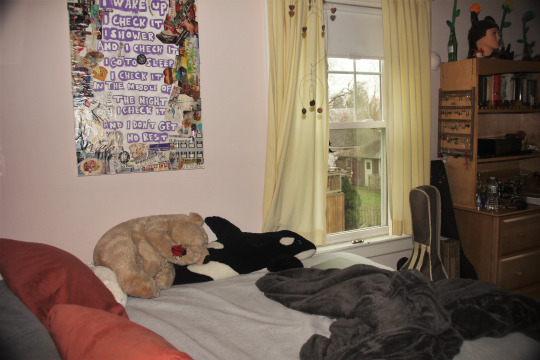
[x] “My Childhood Bedroom”
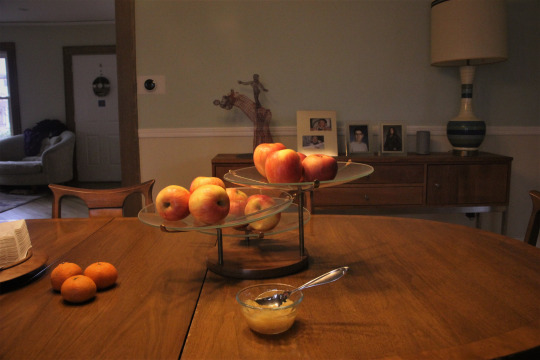
[x] “A Mid Afternoon Snack”
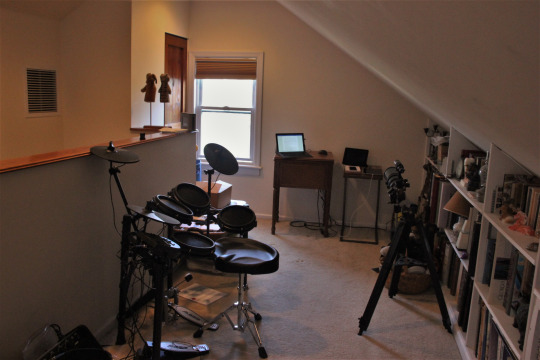
[x] “No space to work, No Space to Practice”
For this project we were asked to make a series of three photos that showed what our life is like in quarantine. For my photos I decided to show what my day to day spaces look like as I have been made to move back home with my family.
The first image is of my childhood bedroom that, because I’m not home all that much, hasn’t been redone since I was four. I chose this photo because it is where I have been spending a lot of my time and, despite the fact that I have managed to put in some objects that fit more of my interests now like the guitars under the window, a lot of what is in the room has been there since I was young.
The second image I chose to show was the view from my seat in the dining room. My family always sits in the same seat so I have had the same view since I was four. While in the foreground of the image you can see the food my mom has chosen to eat and just behind that some more fresh fruit we have managed to get, in the background there is more of my family with images and art we choose to display.
Finally, the last photo I have chosen to include as part of the series is of a corner my attic. Because we are all stuck inside and my parents are both working from home we have learned to fit our selves in where we can. This part of the attic that is usually reserved for my brother to practice on the drums has also become where my dad does his work. Due to this the two of them have had to learn how to share the space so they don’t get in each others way.
An important aspect of all three images is that, while they do show aspects of what it is like to live with my family and it is clear that we are all stuck in the same house, no member of my family is physically in any of the photos. This is meant to create a lonely feeling in the work because during this quarantine, while it is true I do have my family here, it still feels very lonely since I don’t have anyone my own age here that I can relate to and the only way I can see my friends is through a screen.
0 notes
Text
Week 10: Photographic Exhibition
(All image credit given to the respective artists)
Karen Knorr Gentlemen 1981-1983
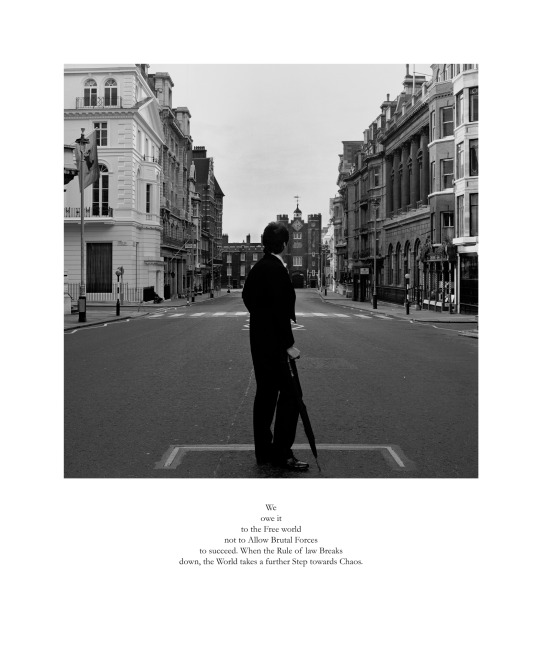

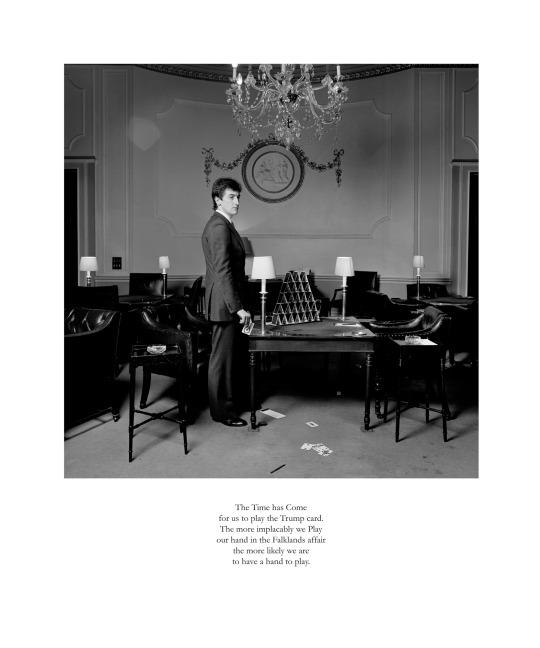




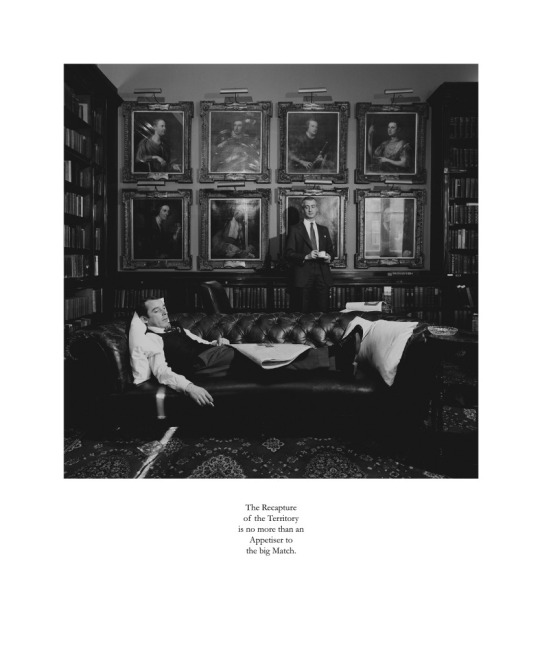
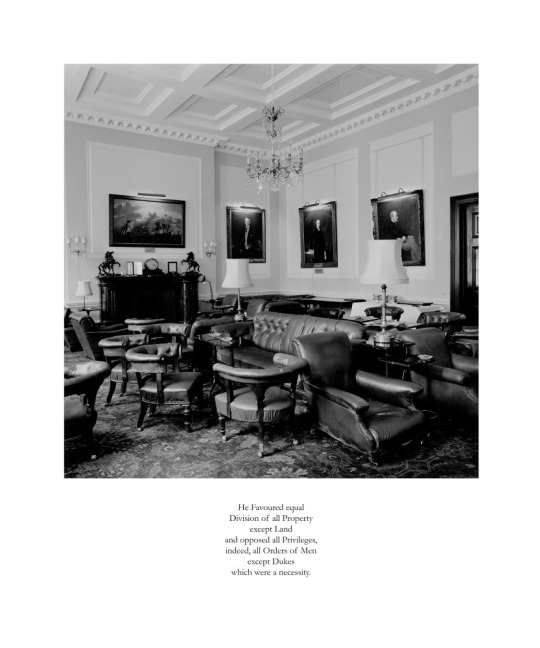
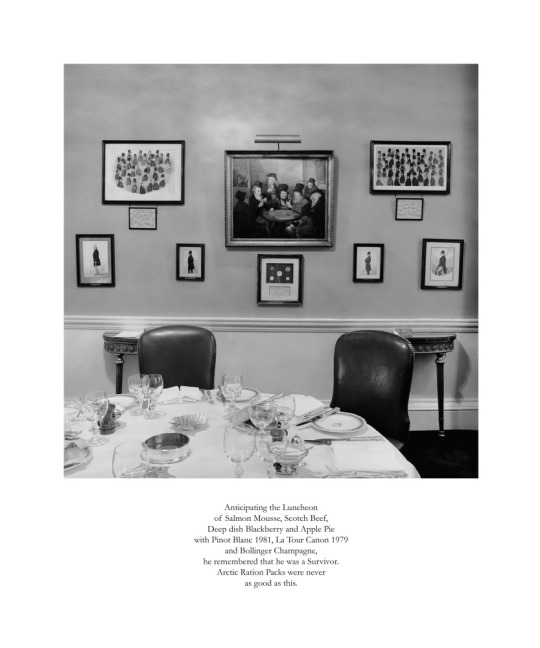

Choose one series of photos and explain why and for whom you think these photos were taken.
There are twenty six total images within this series however, for the sake of time and space, and because I feel all twenty six are not necessary to understand the series as a whole, I have decided to only include the first eleven. I feel that the intended audience for this series was the public with specific focus on those of lower classes who could not enter the gentlemen’s club particularly women.
What, overall, can you understand about masculine identity from this exhibit?
The idea behind this exhibit was almost to call out the gentlemen's clubs for their outdated idea of women as even as Prime Minister Margret Thatcher was only an honorary member of some of the more elite clubs. The view of masculinity and the masculine identity within this series is one of power, both personally and politically, and the want to be viewed as above others simply for their wealth and gender.
Is there anything about the works you have seen by following these links that you find problematic or that you think is worth of praise, or both? What makes it so – style, subject matter, a combination of both, other?
As far as the works that I found by following the links provided in this project, I found many of them to be interesting as they called on the different aspects of masculinity, both the patriarchal view and the more “feminine” view. I felt as a collection it really shows the allowance for diversity even within one definition. However, the issue I had with some of the collections is that, while I understand taking photos with a specific view point or in a way that makes the viewer uncomfortable so they become aware of the meaning, I felt there were a few photos that almost took this too far to a point where the meaning is lost because the viewer finds them self simply too uncomfortable to see further into the ideas behind the photo.

Peter Hujar, David Brintzenhofe Applying Makeup (II), 1982
Analyse closely how the subjects are depicted – what has the photographer chosen to include/ exclude from the photo? Look at camera angle/lighting/focus etc. How does this influence the way you understand the message of the photo?
For this photo the photographer chose to focus on the face of the male subject as he puts on makeup. They have also chosen tho take this photo in black and white which causes there to be a lot of contrast between the mans pale skin when compared to his dark features and the dark background. Through the lighting, the image being in black and white, and the very defined focus on the face of the man in the image the photographer has managed to exclude the mans surroundings without actually having to black or crop them out. This forces you to look at the mans face and come realize the actions he is taking.
What is the relationship between the photographer and the subject(s) in these photos?
The photographer of this photo seems to have a close relationship with the subject simply due to how close he is to his subjects face and how he is being allowed to not only view but photograph a private moment and action. It is also interesting where the photographer chose to place himself as it almost makes the viewer feel like they are part of the mirror this man is looking into in order to apply his makeup.
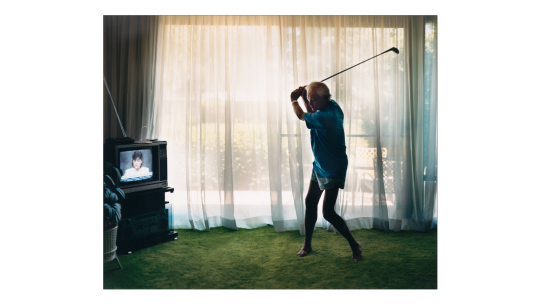
Larry Sultan, Practicing Golf Swing, from the series Pictures from Home, 1986
Analyse closely how the subjects are depicted – what has the photographer chosen to include/ exclude from the photo? Look at camera angle/lighting/focus etc. How does this influence the way you understand the message of the photo?
The subject in this picture is interesting because he is partaking in an action that one would not usually expect to see indoors. However, because of the natural lighting, sheerness of the curtain, and green almost grass like color and texture of the rug one could image what this man would look like outside on an actual golf course. For this photo the photographer chose to focus on the man in a natural environment, however, it still feels odd because he has chosen to leave out all furniture except for a television that is on and seems to be showing the news. Beyond this the photographer has chosen to go with natural light coming from behind the subject that partially obscures the subjects face and shows much of his body in shadow. This makes it so that the viewer can see what is happening within the photo but also perceives it to feel a bit of as if in a dream.
What is the relationship between the photographer and the subject(s) in these photos?
The relationship between subject and photographer seems personal. Because of the nature of the photo it almost feels as if the man set this all up on his own to practice his swing and someone he lives with happened upon him and decided to take a photo of the weird scene. It allows for the viewer to feel as if they have just happened upon this strange scene themselves while also feeling welcome and like they have known this subject for quite some time due to the personal nature of being in someones living room.
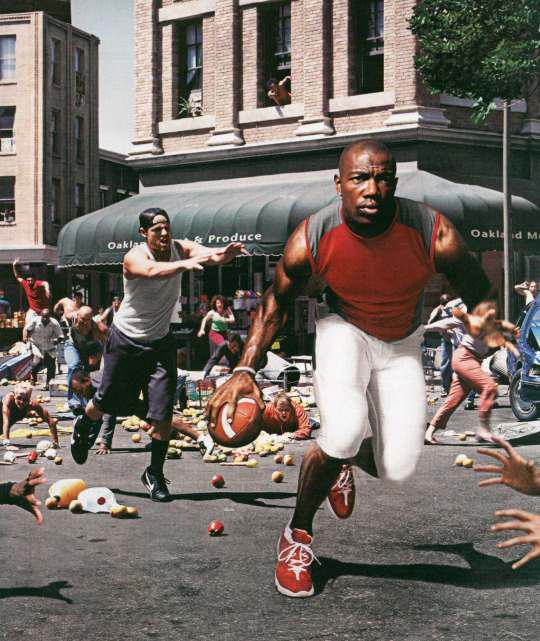
Hank Willis Thomas, Unbranded: Reflections in Black by Corporate America 1968-2008
Analyse closely how the subjects are depicted – what has the photographer chosen to include/ exclude from the photo? Look at camera angle/lighting/focus etc. How does this influence the way you understand the message of the photo?
This image feels almost collage like with the football player running through a crowded street strewn with grocery store items as a strange assortment of people race or at least reach after him. In all it creates a strange scene with the viewer immediately looking at the football player who seems focused as if in the middle of a game despite his lack of helmet and padding. The viewers attention is then pulled to the strange scene that surrounds him. The photographer has chosen to leave out nay explanation for the strange assortment of items or a reason as to why so many people are trying to reach this man. He has also left out many people’s bodies as in many situations only hands are reaching for the man with the football. This aspect of the missing back story cause the viewer to look at the image more intently only o find that it is filled with interesting and confusing background scenes.
Another interesting aspect of this photograph and a clear choice by the photographer is that the image seems to almost be over exposed. The colors are dull and the only part of the image that seems to be exposed properly for the lighting of the image is the man with the football himself. This causes the eye to be drawn to him like a magnet since he becomes the most color saturated part of the image.
What is the relationship between the photographer and the subject(s) in these photos?
The relationship between the photographer and the subject, if you were to pretend that this image wasn’t staged or edited, seems to be that of a stranger. Based on where the image is taken from and the fact that the subject seems unaware of the camera I would say that the photographer was just another person in this crowd who happened to snap a photo and got lucky with this shot.
0 notes
Text
Week 10: Activity 1
(I don’t know who took these photos but I give all credit to the original artist)
“Horn of Africa famine: Somalia, Ethiopia and Kenya suffer worst drought in 60 years”
The worst drought in over half a century has hit parts of East Africa affecting more than 10 million people. Thousands of families have travelled for days across scorched scrubland from Somalia to Kenya, including barefoot children with no food or water after their crops and livestock were destroyed by drought. More than 10 million people have been affected across the Horn of Africa. Acute malnutrition has reached 37% in some parts of north east Kenya and child refugees from Somalia are dying of causes related to malnutrition either during the journey or very shortly after arrival at aid camps.” The Telegraph (11 July 2011)
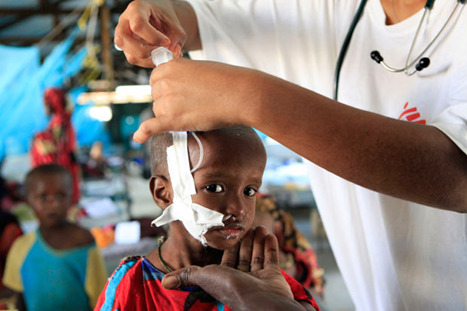
Why I chose this as my leader image.
I chose this image as my leader image because I felt it caused intrigue from the viewer due to the subject matter and the way the child is looking straight at the viewer while also illustrating a lot of what the passage was about.This image depicts a sick child, possibly due to malnutrition. Their head is much smaller than the hand that is reaching out to them and their clothes seem to be ripped or at least well worn. Similarly, the child in the background, though blurred, seems to be wearing a shirt that is too big and is falling off to one side. I feel like this photo works as a good entrance photo into the dark subject matter while still showing some of the common struggles faced by these people.
What aspect of the article does the image illustrate? That is to say, does the image help you visualize one particular part of the text? Which one?
This photo helps to visualize the medical struggles of the children as this child has a tube going into their nose and seems oddly small. It also brings to question where the other adults are as the only adults in the image seem to be doctors rather than the parents you would expect to see with children this size.
In what light does the image present that aspect of the article that it illustrate? That is to say, what comment does the image make about that aspect of the written text?
This image comments directly on the struggles of the children when it comes to malnutrition and other medical needs. While it approaches it in a less visually aggressive when compared to some of the other images, it still manages to get the idea across in a way that is clear.
How does the image help you engage with the written text? That is to say, in what ways does your chosen image influence how you understand the text?
It puts a face to what is written in the text but because of the appearance of the children, the fact that they at least have clothing and don’t appear fully emaciated at first glance, as well as the fact that the image is colorful makes them seem more easily relatable children you have seen perhaps in your community and less like children who simply live far away and are suffering. In a way it humanizes them.

What aspect of the article does the image illustrate? That is to say, does the image help you visualize one particular part of the text? Which one?
This image shows how people travel great distances despite age and physical disability. When you read that due to the drought people are traveling across deserts in horrible conditions, while you recognize it as a bad situation, you can’t put a face to it. Its simply words on a page. This allows you to see both the young and the old side by side.
In what light does the image present that aspect of the article that it illustrate? That is to say, what comment does the image make about that aspect of the written text?
The image says that, while the article may have seemed to focus on the children and their struggles and deaths due to the travels they were made to face and the malnutrition they experienced, there is also the older generation that needs to be thought of. Those who lost their crops and their livestock who, despite their age and inabilities, still make the trek in search for a better life.
How does the image help you engage with the written text? That is to say, in what ways does your chosen image influence how you understand the text?
This image made me realize that, while the text made me want to focus on the children, I also needed to think about their older relatives who had to look after them during this long trek while still managing to look after themselves. Who had to make sacrifices and still saw their children sick, starving, and dying.
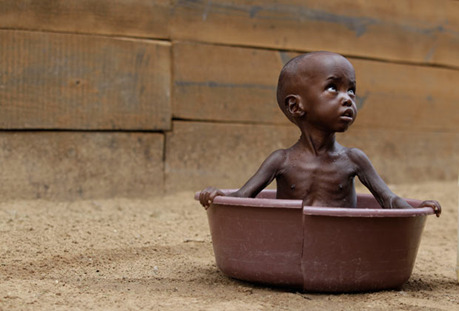
What aspect of the article does the image illustrate? That is to say, does the image help you visualize one particular part of the text? Which one?
This image illustrates the struggles of hunger, particularly of the children, in a way that is more graphic and does not allow the viewer to look away. This child is clearly starving and, while it is mentioned in the article, this image illustrates that point of starvation in way the written word simply could not show.
In what light does the image present that aspect of the article that it illustrate? That is to say, what comment does the image make about that aspect of the written text?
This image comments on the full extent of the starvation faced by the people written about in the article. Not only is this child so clearly emaciated, but the container which they have been placed in which may have been meant to hold food or water is cracked and thereby not useful. It shows how, even if resources were available, the people don’t even have the tools they need to care for themselves.
How does the image help you engage with the written text? That is to say, in what ways does your chosen image influence how you understand the text?
Much like the previous images this image shows what the text can not. It is one thing to say that the people are starving. It is another to see a child so small and so thing that they may as well be skin over bone. This is something that, no matter how well you write about it or how many times you read about it, you can not fully understand until you are able to see it for yourself.

What aspect of the article does the image illustrate? That is to say, does the image help you visualize one particular part of the text? Which one?
This image speaks to the part of the article that speaks about the herds that so many have lost due to the long drought they have been made to face.
In what light does the image present that aspect of the article that it illustrate? That is to say, what comment does the image make about that aspect of the written text?
This image shows people with their herd of goats and, while this herd might seem large to some people, the question becomes will it be enough for milk and meat both to feed the family and for them to have something to sell and even so, how is this family meant to get the money to be able to provide food and water for this herd to live on when everything has been turned to desert?
How does the image help you engage with the written text? That is to say, in what ways does your chosen image influence how you understand the text?
So far we have seen in the images and heard in the article people who have lost everything due to the drought. However, this image shows people who may have a little something left but even that causes strain on them. Even that is just something else they have to manage and afford to care for.
0 notes
Text
Week 9: Photo, Caption, Cropped
Photos 23+24
Photo 1:

[x]
Photo 2:
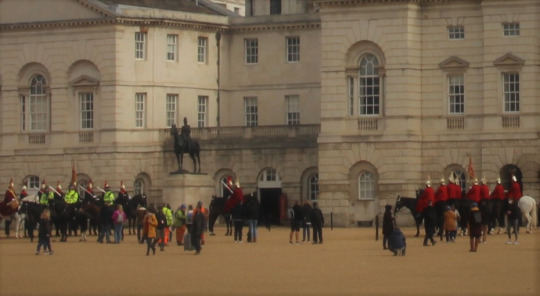
[x]
Photo 1:
I felt this photo has meaning because it shows historical buildings and practices along with construction and other aspects of modernity. It shows how there can be this collision of modern practices and historical practices without one ruining the individual aspects of the other.
Caption ideas:
History meets modernity
A mid afternoon chat
Changing of the guard
Photo 2:
I decided to crop this photo in a way that got rid of all of the construction that was happening near this building. I did this because it forces the viewer to only look at the building and the events that are happening rather than looking at the bright colors of the construction workers. It also makes it so that the image is no longer about the construction, restoration, and gentrification of the area and only about the old traditions. It is less of a political or situational commentary on what is means to try and modernize and area while still keeping its historical importance and becomes a focus on the old traditions and how they have remained unchanged.
0 notes
Text
Week 9: Gallery Activity
Mohamed Bourouissa
What is the main message of this artist’s work?
The main message behind the work of Mohamed Bourouissa seems to be one of community, generation, and resilience.
How is this conveyed? (What techniques is s/he using?)
He often shoots a mix of people he knows and people he doesn’t in a way that shows human connection. He also shows aspects of the world specific to the experience of his generation such as certain types of clothing, people smuggling cigarettes, and people stealing from a supermarket. Another way Bourouissa gets his message across is through the types of people he decides to photograph. As he said in his interview many of his subjects are immigrants or from the suburban areas of the city which allows him to have a more diverse subject base as well as show the different type of people that live in Britain and France.
In your view, which artist should win the competition? Why?
While I love the idea and follow through of Bourpuissa’s work I do not feel he should win. The idea is there but I feel there are aspects of his narrative missing simply because he gave himself such a large subject. for aspects of his series he focuses on diversity and community but for others he begins to focus on this idea of generation and identity within a generation. It is here that I feel he has lost some of his footing. For this idea of generation he does focus on community and diversity but he also gives a large amount of focus to clothes and external aspects of self representation. It is my belief that if you want to show the experience of a generation you cant simply focus on one style but rather you have to get a feel for the diversity of experiences and forms of self representation. I feel this series could have been made stronger by focusing more on one aspect of his message rather then making it so broad.

Mohamed Bourouissa La Prise, 2008 From the series Périphérique
This image is interesting because it makes the viewer feel as if they have walked in to a very personal scene and not given any context. It is also interesting because the image its self has been given a very warm feeling with the yellow tint of the entire image which somehow works in contrast to the actual subject matter. As for the message of this image it seems to be one of trouble within a domestic setting and, because of the commonly understood imagery it uses such as the police and one figure being placed beneath the other, it doesn’t need much further explanation. As for the photo its self, it doesn’t really remind me of any other works we have seen because, while it seems like a more naturally taken photo it also feels somehow staged. This gives it a very different feel when compared to other artists we have viewed who usually have their posed and un posed images separated or want the viewer to realize that the images have been both naturally and un naturally taken.
Anton Kusters
What is the main message of this artist’s work?
The main message of this work is one of heritage and remembrance of the past with specific focus on Nazi concentration camps.
How is this conveyed? (What techniques is s/he using?)
This is conveyed through the use of instant peel of lens which gives the images an older/more classic feel, shots of the blue sky which is a constant both in the time of the concentration camps and when the photos were taken, and the blind-stamps of the number of victims and the GPS coordinates. The message is also given through the fact that each of the images was taken at a know location of a Nazi concentration camp. Finally, the images are accompanied by a thirteen-year-long generative audio piece by Ruben Samama which is meant to represent the thirteen years that the camps were open.
In your view, which artist should win the competition? Why?
While I think these images are beautiful and made even more interesting through the meaning behind them and the very long accompanying audio, I think it is also the sheer number of factors that become the downfall of this collection. I simply feel that this is a good idea for a project but can’t be fully comprehended by a single person. The simple length of the audio means that a person has to dedicate a large amount of their lives to fully experiencing this project. There is also a very large number of photos, many of which are very similar and, while I understand they are all taken in different locations and gain a meaning this way, it makes the series feel very repetitive and doesn't allow it to stand out clearly in the mind of the viewer.

Anton Kusters München-Stadelheim | 0000100 (est.) | 48.100152, 11.592046 (EX) from The Blue Skies Project
I decided to focus on an image that showed many of the photos included in Kusters’ collection because it seems they were meant to be viewed together so that the viewer could understand the sheer number of locations. Kusters chose to use an older style camera as a way to take his images because the type of film its self is quite delicate. It also allowed him to have the space to write in the number of victims and the GPS coordinates without disturbing the actual image. Besides this he let the sky its self decide many of the aspects of the photo. While I feel this is a very meaning heavy series I don’t think it would be fully understood without first reading an explanation of the series as a whole. Without first reading this the numbers would not make sense and it would simply seem like a collection blue and white circles. This series reminds me of the work done by Simon Roberts in his series The Weeds and the Wilderness as it is many photos seemingly of the same object and it is not until you read the explanation and take a closer look at the images themselves that you begin to understand the true meaning behind them and begin t notice their individual features.
Mark Neville
What is the main message of this artist’s work?
The main message behind Neville’s series is one of community and self representation within a community as well as an understanding between animals and people whether that connection is as a pet and owner or as owner and eventual food.
How is this conveyed? (What techniques is s/he using?)
This message of this series is conveyed through both posed and non posed images that were taken in a small rural community named Guingamp. In this community a lot of the people are agricultural workers and while taking photos of the people Neville began to gain an understanding of the relationship people had with the animals they lived with. With this gained understanding he had people pose with their animals in a way that showed a sort of kinship with them. He also published a written works in both English and French that is meant to spread awareness of and support the protection of agricultural land and workers.
In your view, which artist should win the competition? Why?
I find the work done by Neville to be interesting and overall useful to the general public as he allowed for it to reach past simply his focus and instead make an impact on the world of agriculture. The point of this award is to find a good artist who’s work is innovative and for me that means an artist who is attempting to do something that goes beyond their work and will have a longer lasting impact. With the literary books that came out along side this photographic project I feel Neville has put himself in a position to make a difference both in the world of photography and agriculture awareness. I also feel that the care Neville put into each image shows through so beautifully making it clear that he wasn’t simply taking these images of people with their animals because he thought it would be cute or a good change from the norm. But rather that he truly understood how the people and animals related to each other both for companionship and sustenance.

Mark Neville Parade #39, 2019
This image stuck out to me because of the sheer strangeness of the image its self. The pig and the woman seem to be looking in the same direction and almost have similar expression. Also the positioning and placement of both the pig and the woman seem unnatural and uncomfortable, perhaps this is because the pig was most likely lined up to one day become food for the woman. For this image Neville chose a considerably dark, dirty, and almost uninteresting background which pulled more attention to the face of the woman and the pig as both were light and clean in comparison. This is not to say that the background didn’t pull any attention at all, however, it simply was something the viewer would glance at, consider for a moment, and then move on from. This image is also interesting because it almost has two focal points and they are in very different locations within the image. While both the face of the woman and the face of the pig seem like focal points, the fact that they are so far from each other make it so that more of the image comes into focus and one is also made to look at the slumped and almost confused way both the woman and the pig seem to be sitting.
This image does begin to make a bit more sense after reading about Neville’s series because the viewer gets an understanding for why the photographer wanted to take a picture of this woman and her pig in the first place. The viewer also begins to understand that the background may not have been chosen at random but instead may have been something important to the life of that woman or that pig.
This image reminds me of many of the portraits we as a class saw in the national portrait exhibit because it has such a clear focus and is such a clean and clear image, yet the actual feeling and story behind it are both clear and hidden at the same time. The image makes the viewer want to look at it longer and learn more about the subjects.
Clare Strand
What is the main message of this artist’s work?
The message behind the works of Clare Strand is that of communication and the way the information is given and received between two individuals.
How is this conveyed? (What techniques is s/he using?)
This idea was conveyed through the use of multiple mediums as Strand worked with her husband in an attempt to show how information, no matter how clearly it might seem to be conveyed, can lose some of its meaning along the way. Strand and her husband took multiple images and broke them into a grid system. From there they assigned each square of the grid to a number that was associated with a specific tone of grey they felt was best represented within that original grid square. From here Strand’s husband would tell Strand square by square which number had been assigned and in turn Strand would use that color to fill in a correlating square on her canvas. Because the squares could only each be s single color and because Strand herself could not see the image she was attempting to copy the final painting often came out as a pixelated version of its self rather than a perfect copy of what Strand’s husband was seeing.
In your view, which artist should win the competition? Why?
I love the work done by Strand. I feel that it is an interesting view on our ability as humans to communicate effectively and in a way that can be understood without losing meaning. However, I feel that as far as this award goes Strand’s work doesn’t have as many current real world connections. As much as I want Strand to win an award I don’t think this is the one for her to win based on the projects of the other artists.

Clare Strand The Discrete Channel with Noise: Information Source #3 (2017 - 2018)
I chose this image because I found the before image to be almost more interesting then the painting that was made as a reaction. The after image may have shown the true in intention and outcome of the series in a more visual way but it seemed to me that the before image with the lines and the numbers showed the intention and the amount of work that went into each aspect of this series. For this image the original focus seems to have been the man with his camera as he takes a photo of an item the viewer can not see. However, after making the grid and assigning the number to the image the focus changes these lines and numbers as the viewer is made curious of what is to happen.
This image does make more sense after reading about Strand’s study because without the explanation it just seems like someone has drawn numbers and lines all over an image. It also allows the viewer to look at the image and wonder how they would have chosen to convey this information or in turn, how they would have made the correlating painting.
While the original painting reminds me again of the portraits from the portrait gallery due to its clear focus and underlying story, I don’t think this series by Strand can really be related to anything else that has been made. The photos and the way they are split up make them very personal and individual to the creator.
0 notes